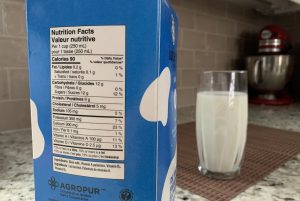 Like all perishable foods, milk and cream must be handled and stored correctly in order to maintain their quality and safety.
Like all perishable foods, milk and cream must be handled and stored correctly in order to maintain their quality and safety.
Buying Milk and Cream
Always pick up your milk and cream near the end of your shopping so they will stay cold as long as possible. Be sure the milk is cold and the containers are not leaking.
Best Before Date
The best before date indicates how long the unopened product will retain its freshness and high quality. Select the freshest product available. Pasteurization, the process of rapidly heating raw milk, holding it for a short specified period of time, then rapidly cooling it, removes most of the bacteria from milk and cream. Some of the remaining harmless bacteria can grow and multiply, although very slowly, at refrigerator temperatures, eventually causing the products to spoil.
For optimum quality and food safety, milk and cream should be used by the best before date.
Once opened the best before date no longer applies and the storage life depends on how the milk has been stored and handled by the consumer. Milk and cream that have spoiled should be discarded.
Keep Milk and Cream Cold
In warm weather, if your trip home takes longer than 30 minutes, bring an insulated cooler with ice to keep milk, cream and other perishable foods cold. Once in your kitchen, place these foods in the refrigerator as soon as possible. Store milk and cream on refrigerator shelves rather than doors which are not cold enough, rotating them to use older products first. Regularly check the temperature of your refrigerator. It should register 4°C (40°F) or lower. All opened milk products are perishable, including canned and UHT milk and should be refrigerated. Once canned milk is opened, it should be refrigerated. Use canned milk within 7 days of opening.
Handling Milk
- Store milk in the original container to safeguard quality and freshness.
- Keep milk containers cold and away from strong-smelling foods.
- To avoid cross contaminating milk, do not return unused milk from a serving pitcher to the original container.
- If milk has been left at room temperature for longer than 2 hours, throw it out.
Freezing Milk
Milk may be frozen for as long as 3 months, provided the sealed container is frozen prior to the best before date. Skim and 2% milk freeze better than homogenized milk (whole milk). Thaw frozen milk in the refrigerator. If upon thawing it separates, shake well or beat with an electric mixer or rotary beater. Unopened eggnog may be frozen for 2 months, provided it is frozen prior to the best before date. Thaw in the refrigerator and shake well before serving as there may be some ingredient separation during freezing.
Freezing Cream
Freezing cream is not recommended because it affects the quality of the product. In most cases, freezing causes changes to the fat which can lead to poor texture.
Powdered Milk
An unopened container of dry powdered milk can be stored in a cool, dry place for 6 months to a year. After the container has been opened, always reclose it tightly and use powdered milk within 2 months. Once reconstituted, it should be handled and stored as regular milk.
Buttermilk
Buttermilk is produced by adding bacterial cultures to milk and warming it to cause fermentation. Part of the milk sugar is converted to lactic acid, which gives buttermilk its characteristic “sour” flavor. Buttermilk should be used by the best before date. Once opened, the best before date no longer applies and the storage life depends on how the buttermilk has been stored and handled by the consumer. Buttermilk may be substituted for sour milk in recipes. If a recipe calls for buttermilk you may substitute 1 tbsp (15 mL) lemon juice or vinegar plus enough milk to make 1 cup (250 ml); let stand 5 minutes.
Micro-Filtered Milk
This milk goes through a patented micro-filtration process which combines cold-filtering and pasteurization. This process removes more of the bacteria than pasteurization alone. Micro-filtration has no effect on the nutritional content but does increase the length of time milk may be refrigerated without changes in quality and food safety.
UHT Milk
UHT milk has been pasteurized before packaging by a special method involving Ultra High Temperatures (UHT). Because of this process, UHT milk may be stored, unopened, at room temperature for up to 3 months from the date of processing. Check the expiry date on the carton before purchasing. After opening, refrigerate UHT milk in its original container, and use within 7 days.
Unpasteurized Milk and Cream
Some consumers believe that it’s healthier to consume unpasteurized raw milk or cream. However, this is not true. No matter how careful a dairy farmer or milk processor is or how hygienic the conditions, disease-producing bacteria may be present in unpasteurized raw milk. Current legislation makes it illegal to sell or give away raw milk or cream anywhere in Canada. Pasteurization improves the safety of milk but does not affect its nutritional value.
THIS INFORMATION PROVIDED BY THE FOOD SAFETY INFO LINE
A PROJECT OF THE ALBERTA HOME ECONOMICS ASSOCIATION
The production of this fact sheet has been supported by Agriculture and Agri~Food Canada, Agriculture and Food Council of Alberta, the Canadian Adaptation and Rural Development Fund; and Alberta Milk Producers.






